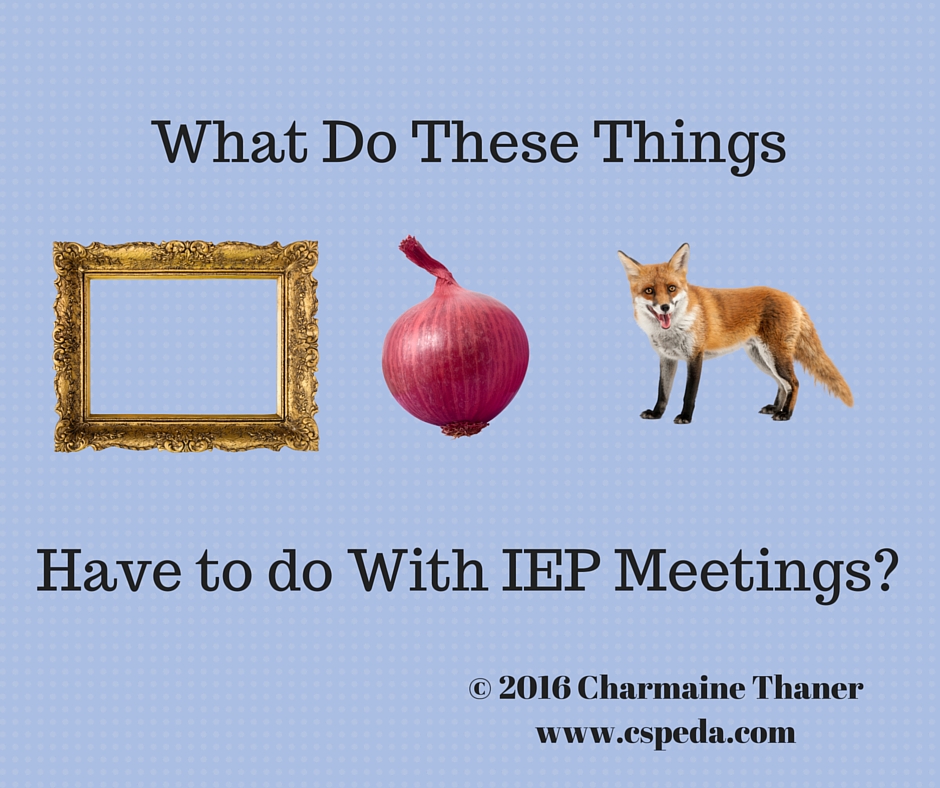What Do These Things Have To Do With IEP Meetings?
What Does a Frame, Onion, and Fox Have to do With IEP Meetings?
You probably have experienced being at an IEP meeting and having disagreements on the spirit of IDEA. No doubt, you‘ve run across a District’s interpretation of your child’s rights being different than yours. You know a well written IEP will only get your child so far if it is not implemented. Right?
How do you take your advocacy skills to another level? How can you change from being a great debater to being a great collaborator? Read on for the answers.
The first three steps are to: 1) Grab a new picture frame, 2) Get an onion, and 3) Think of a fox.
Your picture frame is going to remind you to “Reframe”. Often when you reframe you’ll be doing the opposite of what you usually do. Treat the person you disagree with as a partner.
• Instead of disagreeing with what the staff says, accept it, and reframe it as an opportunity to talk about the concerns.
• Redirect the other person’s attention away from the line they drew in the sand and instead toward identifying their underlying interests and inventing creative options.
• Reframe it by saying, “That’s interesting. I wonder what that would accomplish. How would it be helpful? What problems might it solve?” When the other person begins to answer, the focus of the conversation shifts from positions to interests. Want to know why speaking of interests is critical, Click here to watch a short video about it.
The onion symbolizes the peeling back of layers of disagreements. By asking questions you will uncover the core issue (interest) for each person. Doing this shows respect and valuing of others. It also helps highlights information needed to reach a consensus.
• Ask some probing questions. Remember, your body language and tone of voice need to show genuine curiosity in order for the conversation to be beneficial.
• Examples of questions to ask: “What benefits do you think we can expect if we try that?” “What if any would be the disadvantages if we tried it this way?” “What do you see happening if we go in that direction?”
• When you understand why a person wants what he or she wants, there is a better chance of positive solutions being agreed to.
Thinking like a fox will help you know how to adapt to change, be a creative thinker, and understand the importance of community (the pack). When advocating for your child there’ll be challenges and occasional roadblocks. Here are some ideas to be a survivor.
• Be ready for changes by being proactive. Make it a practice to have regularly scheduled conversations with the key players at school.
• Develop your creative thinking skills by brainstorming possibilities with others. Stay focused on the outcomes you want for your child, and be open to more than one way to get there.
• Keep in touch with others that share your interests and values. Give yourself permission to have fun with friends, combine bouncing ideas off of friends with coffee or a lunch, celebrate the good things happening at school with others.
Would you love some more tips for changing up IEP meetings and creating a WIN for your child? Well, click on over to Amazon and get my new book, The Art of Advocacy: A Parent’s Guide to a Collaborative IEP Process. Get your book today before the price goes up!
Remember, change is possible. Let’s make it happen!
